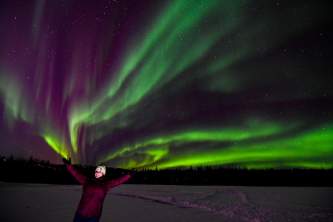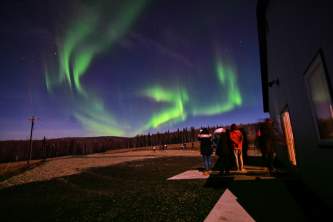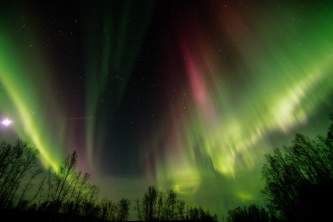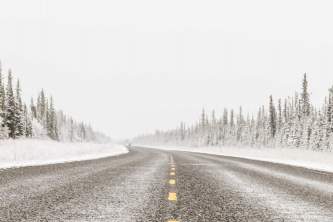Cross Country Skiing For Beginners
So the snow has fallen, and hundreds of cross-country skiers are abroad on Anchorage’s vast system of multi-use and groomed ski trails. But what a dizzy array of techniques and speeds!
It can be confusing
Athletes in tight Lycra rocket past, moving like speed skaters as they plant poles in explosive, rhythmic motions. Others seem to shuffle along, moving one ski forward and then another.
One group with wide skis trundles out of untracked forest, kicking through drifts and untracked snow. Others shoot down icy straight-aways, tucked as though downhill racers. Still others seem to pump up and down as though listening to a rock music beat, kicking and gliding with skis shifting up and back in the parallel ruts like pistons.
And then there are the skis. Some are long, some are short. Some are curvy and fat, with metal edges and scaly bottoms. Others seem so skinny that you fear you won’t be able to stand on them without falling down.
You’d like to try it out, but where do you begin?
An orientation
Unlike alpine skiing at a resort, cross country skiing generally means “free heel.” Your boot toe is attached to the ski binding while your heel rises off the ski as you move around. This configuration allows great freedom of movement, especially for climbing hills and accelerating down flat trails. It’s what makes XC skiing intuitive and feeling natural.
Skiers use two basic techniques — Classic and Skate
Classic XC skiing is probably what you visualize when you think of Nordic skiing. Using poles to assist, you glide or shuffle forward on alternating skis that move parallel to each other—first one side and then the other. This technique is most versatile and can be used for traveling just about everywhere there is snow—through unbroken powder, traversing backcountry slopes or moving down parallel tracks set into the groomed trails.
Heed the pocket
A key to classic skiing is the pocket beneath the boot. Classic skis have camber—they are slightly arched so that the portion of the ski beneath the boot is held off the ground. When skiers weight that ski, the pocket gets pressed into the snow. Wax or texture on that bottom grips the snow surface, allowing skiers to push off in a spring that sends them gliding forward for a second or two on the opposite ski. As the glide tapers off, the skier shifts and performs the same maneuver on the opposite side.
Poles complement the technique. Skiers plant the pole on the same side that’s being weighted and push off. At the same instant, they spring onto the opposite ski for the glide and swing the opposite arm forward for the next plant.
Diagonal stride is intuitive
This “diagonal stride” goes back and forth, side to side. Like this: On right side, ski gets weighted and pole is planted. On left side, ski glides and pole arm swings forward. And then you reverse. All on a one-two, one-two count.
The overall motion can be very intuitive. It mimics the natural motions that you would make if you were taking a brisk walk or climbing a hill using ski poles. Once you’ve done it for even just a few minutes, it quickly starts to feel right.
Skating for speed
Skate XC skiing is a bit different. The skis are skinnier and shorter, with no pocket for gripping. Moving forward requires the skier to glide with alternating skis moving at an angle to each other, pushing off side-to-side much like hockey skating or figure skating. In fact, experienced ice skaters have a head start—without poles, the motions are very similar.
This technique relies a firm surface to work well, with snow typically no deeper than an inch or two. While skate skiers usually stick to groomed trail systems or packed routes, the technique can be a blast if weather has produced a firm crust in the wild. Spring conditions on Alaska’s wetlands and alpine slopes often allow skate skiers to travel for miles in and out of the backcountry. Light snow cover on a frozen lake or creek can also make for great skate skiing.
Begin with classic
Novices should start with classic skiing. It is easier to learn and takes much less time to become proficient enough to have fun touring around. In fact, you can probably be classic skiing and enjoying a basic shuffle-glide technique in minutes.
Some recommendations:
- Look for a classic touring ski with wax-less or fish-scale bottoms. If you plan to ski mostly off groomed trails or in the woods, get a “backcountry” version with metal edges. If you plan to ski mostly around town, especially if you want to use the set tracks, then look for a “medium” width ski without the metal edges.
- Why get skis with “fish-scale” bottoms? It’s less to deal with as a beginner—and with the skis always ready to use, you can just grab them and go. Without that texture in the pocket beneath the boot, you will need to buy wax and then coat that segment of the ski with a wax that works for the specific snow conditions you plan to ski that day. It can be challenging to get right, especially when the snow is near the freezing point.
- About waxing. Done correctly, waxing makes for much faster classic skiing. Plus, waxing can be an art all by itself, with dozens of choices and grades, all keyed to snow temperature and texture. Mastering the application of wax is essential for racers and those seeking serious performance. Still, under most conditions, simple waxing for recreation is not that complicated and can be interesting. (Children in local ski leagues wax their skis before every practice.) Go for waxable skis if you think it sounds intriguing and are willing to take the time to learn and spend the money on waxes and some application tools.
- Whether seeking waxless or waxable skis, you’ll probably get best results by buying a new pair of introductory models from one the local ski shops. Skiing is one sport where some “expert” gear advice at the front end really pays off. In a shop, you can talk over your goals and experience with a knowledgeable sales person. A good ski shop will then “fit” you to the ski. Often shops sell introductory skis, bindings, boots and poles in a discounted package deal that’s reasonably priced.
- Buying second hand or from a private party? First, try to make sure the skis fit you. Basically, the flex or camber beneath the boots should be stiff enough to support your weight with a slight gap under the ski for gliding. It shouldn’t be pressed flat to the floor when standing on both skis.
- How to fit? With your weight equally distributed to both feet, stand on the ski with toes at the binding clip or the spot just behind where the ski balances. A friend should be able to slide a paper back and forth beneath the skis under your feet. When you shift all of your weight to one side or the other, the weighted ski should compress enough to trap the paper against the floor.
- Length? The skis need to be long enough to support you, but not too long to trip you up. Try this: Hold ski vertically, with tip toward the sky. Raise one arm and reach for the tip. The tip should be about even with your wrist. Shorter is better than longer.
- Classic poles should be about even with your chin when planted on the ground at your feet.
- Bindings? There are several different styles of bindings. As a novice skier, most types available for introductory touring skis will work fine. If they’re already mounted on the skis, then you will need to make sure whatever boots you pick matches them. If the skis don’t have bindings, or you have choices among bindings, pick the boots first.
- Boots? You want to buy the most comfortable and warmest pair of classic boots that matches your budget (and, if necessary) fits the bindings on the ski. When buying ski equipment on a budget, always spend any extra available money on the boots. Your feet will thank you!
- Trying it out. Get an experienced friend to go with you for the first time to an area with grooming or a flat expanse. The Kincaid Park Stadium and Russian Jack Springs Park are both great places for first skis. Put your skis in the tracks and mimic your teacher. Relax and have fun. Remember the old-time ski school adage: Form follows function. You’ll catch on fast.
- A tip for those very first outings: Ski back and forth without poles in the tracks until you can kick and glide a bit. Don’t start using the poles until you feel comfortable and stable on the skis without them. The poles are not intended for balance but to help with propulsion!
Want to take lessons?
Instruction will get you started with better form and help you improve faster. An hour on skis with an instructor can be free or cost as little as $7.50 for kids.
Check with the Anchorage Parks Department or the Nordic Ski Club of Anchorage.
Some quick links:
Little Nordic Ski Club (kids ages 4-5)
Junior Nordic League (kids ages 6-14)
This program is where many of Anchorage’s competitive ski racers learned and became fast. Held three days per week, with two sessions per season, with groups based at several venues around town. You can rent skis that match several models of inexpensive kids boots too.
Anchorage winter activity guide for 2017-18
The city parks department offers ski lessons for adults and children. Check the current copy of the Winter Activity Guide. Lesson details are on pages 10-11 in the 2017-18 edition.
Children’s ski lessons by City Parks Department.
A link to a reservation page with current times.




